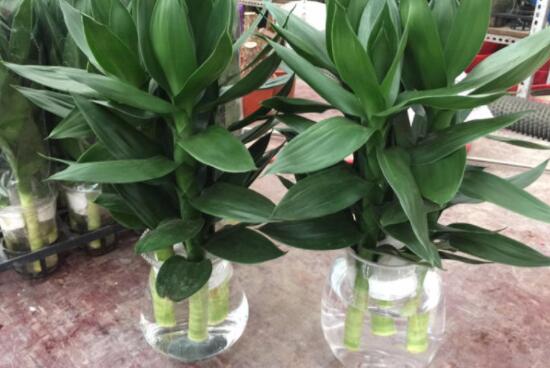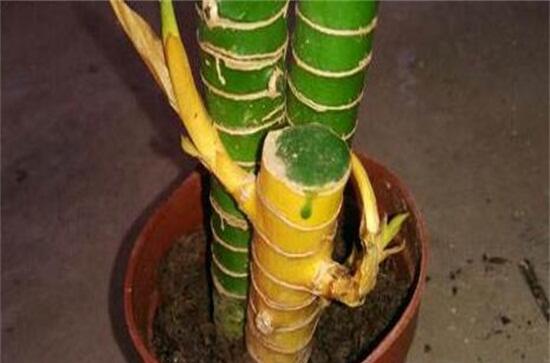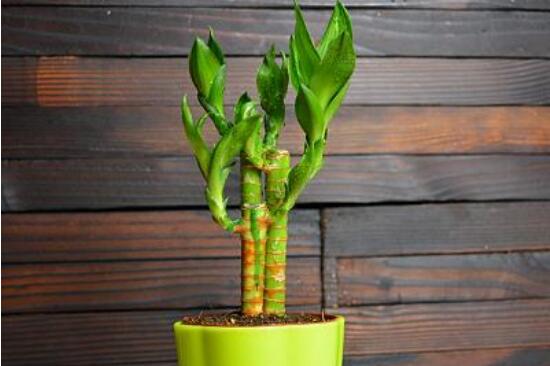Lotus bamboo can be cultured in water? Lotus bamboo water culture method/avoid cold wind 15 natural roots
Lotus bamboo, just like its name, its stem is like bamboo and its leaves are like lotus flowers. It looks very beautiful and is deeply loved by flower friends. However, in indoor culture, many flower lovers prefer water culture to soil culture. Can lotus bamboo be hydroponically cultivated?. If possible, how can lotus bamboos be cultured in water? Next, let's go with the editor to take a look at the aquaculture method of lotus bamboo.
Can lotus bamboos be hydroponically cultivated?

Lotus bamboo likes a humid environment, and its vitality is strong, and its leaves can survive by inserting its leaves into the water, so can lotus bamboo be hydroponically cultivated? Obviously, you can. It is understood that lotus bamboo is a kind of perennial fragile green plant, which is not only suitable for soil culture but also very suitable for hydroponic culture, and the ornamental value of hydroponic lotus bamboo is higher!
Second, how to cultivate lotus bamboo in water, changing water once every 3-4 days
1. Container selection
If you want to cultivate lotus bamboo in water, you must first choose a water culture container for it. In this regard, the editor recommends that everyone use a good-looking transparent glass container, so that it is not only good to observe its rooting, but also to look at the white roots of the lotus bamboo against the water.
2. Select water to cultivate seedlings
How do lotus bamboos grow in water? In fact, it is very simple. On the lotus bamboo grown in soil, the branches with strong growth are selected and cut as water-cultured seedlings. Then cut off all the leaves at the base of the branch, and then cut the base into an oblique cut with a knife, which is conducive to better water absorption.
3. Hydroponic culture begins
Insert the cuttings into the water, then change the water every 3-4 days, or put a little charcoal in it to prevent the plant from rotting. After doing so, do not move the glass bottle for 10 days, the lotus bamboo will grow pure white roots in 15 days, followed by hydroponic conservation.
(2) methods of hydroponic culture of lotus bamboo.
1. Change water to add water
After the lotus bamboo takes root, don't change the water so frequently. When you find that the water is reduced, you can add a little water. The reason for this is that if you change the water frequently, it will cause the lotus bamboo leaves to turn yellow.
2. Appropriate amount of fertilizer
In the method of hydroponic culture of lotus bamboo, appropriate fertilization is also necessary. You can add a little nutrient solution to the glass container every three weeks, and just put a few drops when adding water. However, it should be noted that fertilization should be carried out at the beginning of hydroponic culture, and there is no need to add it when the roots of the plant grow out.
3. Avoid cold wind blowing
With regard to the water culture method of lotus bamboo, there is another thing that we must not forget, that is, the location. You should keep the glass bottle away from the air conditioner or the wind of the electric fan to avoid yellowing and withering the edge or tip of the lotus bamboo leaves as a result of being blown by the cold wind.
Can lotus bamboo be cultured in water? methods and matters needing attention in family hydroponic culture of lotus bamboo
Lotus bamboo has a short plant type and strong adaptability. It can be cultivated not only in soil, but also in water. Each has its own characteristics. Although there is a flower word in its name, it is a plant that does not blossom. It is generally used to watch its leaves. Here is a brief introduction to its hydroponic culture methods and points for attention.
Can lotus bamboo be cultured in water?
Native to the islands in the western Indian Ocean and subtropical regions, Chinese mainland was introduced in the early 1980s and planted in large quantities in the early 1990s. It has become the main cash crop in the coastal areas of southern China, and it can be hydroponically cultivated.
Methods and matters needing attention of family hydroponic culture of lotus bamboo
Culture method
1. Before entering, the blade at the base of the cuttings should be cut off, and the base should be cut into an oblique mouth with a sharp knife, and the incision should be smooth to facilitate the absorption of water and nutrients. Change the water every 3-4 days, do not move or change direction within 10 days, about 15 days can grow silver-white fibrous root.
2. it is not suitable to change water after rooting, and water can be added in time only after the evaporation of water is reduced. Often changing water is easy to cause yellow leaves and branches to wilt.
3. If a small amount of compound fertilizer should be applied in time after rooting, the leaves will be green and the branches will be stout. If there is no fertilization for a long time, the plant growth is thin and the leaf color is easy to yellowing. However, fertilization can not be too much, so as not to cause "burning roots" or cause overgrowth. Compound fertilizer can be applied once a month in spring and autumn.
Matters needing attention
1. Temperature control
It is necessary to grasp the temperature of indoor lotus bamboo water culture, because lotus bamboo tends to be warm, moderate at 16 degrees to 25 degrees, not suitable for breeding in cold places, and anti-freezing measures should be taken.
2. Lighting and ventilation treatment
To make the lotus bamboo have enough lighting time, even if it is cultivated indoors, it should be properly exposed to the sun and placed in a ventilated and well-lit place.
3. Fertilize the lotus bamboo.
When some flower friends went to buy lotus bamboo, the seller said that they only needed clear water to raise it, but did not apply fertilizer, and later the leaves turned yellow. In fact, water culture of lotus bamboo also needs fertilization. According to the actual situation, fertilizer can be applied every 30 days on average, moderate fertilization can keep the leaves green and stretched for a long time, or add an appropriate amount of culture medium.
Does the lotus bamboo bloom?
Lotus bamboo is a species of dragon blood tree of Liliaceae. Lotus bamboo is suitable for water culture, pot culture and water culture. High ornamental value, it is one of the few greening and decorations that can be placed indoors for a long time. It is a plant that does not blossom.
What if the lotus bamboo leaves turn yellow?
1. Burning yellow: the strong sunlight shines directly on the lotus bamboo, which is easy to cause the withering of the leaf tip and leaf edge, and the yellow spot appears in the sunny part of the leaf. Just move to the shade.
2. Lack of light and yellow: put in a shady environment for a long time, the leaves can not get enough sunlight, can not form chlorophyll, the whole leaves turn yellow and then fall off, supplementary light can avoid the disease.
3. Fat yellow: the lotus bamboo yellowing caused by too much fertilizer or too much concentration, showing dry brown at the tip of the new leaves, generally the leaves are thick and without luster, and the concave and convex leaves are not stretched, and the old leaves are scorched yellow and fall off. Fertilizer should be stopped immediately and some fertilizers should be washed with a large amount of washing.
4. lack of fat yellow: the color of the young leaves becomes light, yellow or light green, while the old leaves are more normal or gradually change from green to yellow. Usually apply thin fertilizer frequently and add some alum water at the right time. (Lotus bamboo is a foliage plant, which should be fertilized mainly with nitrogen fertilizer.)
Although lotus bamboo has tenacious vitality and strong adaptability, improper nursing is also prone to problems. Yellowing of leaves is one of its common problems. It is divided into burning yellow, lack of light yellow, fat yellow, lack of fat yellow. We should observe carefully to see what kind of reason it belongs to, prescribe the right medicine to the case, so that we can grow well.
Hydroponic culture method of Phyllostachys pubescens 1. Container:
Do not choose shallow bottom, you can put some colored glass balls or pebbles in the container, which can not only stabilize the center of gravity, but also increase beauty.
2. Water quality:
Water bamboo hydroponics can be used in rivers, rivers, lakes, or wells. If tap water is preferably precipitated for 24 hours, mineral water must not be used. The best water quality is acidic water in electrolytic ion water.
3. Maintenance work:
(1) when the water bamboo is hydroponically cultured, the water surface touches the upper end of the root 3 cm, do not immerse too much, lest the rotten root affects the respiration. If there is rod decay, the rotten part must be cut in time to expand the rot-free part, preferably from the bamboo joint. Generally speaking, once the water bamboo takes root, it is not easy to rot. In addition to cutting off the rotten part, you can also put some bright green treasures in the water to promote the roots.
(2) Phyllostachys pubescens has a large evaporation in summer, so it is necessary to change the water every 2 to 3 days in order to keep the water quality from pollution. at the same time, remember foliar spray when the air is dry, and it can withstand night dew at night.
(3) Phyllostachys pubescens has little demand for fertilizer and can be dissolved with one or two pieces of fertilizer tablets with water for a long time to increase nutrition.
- Prev

What about the yellowing of lotus bamboo pillars, strong light shading / lack of water / spraying of diseases and insect pests
As a kind of green plant, lotus bamboo has many functions, but its ornamental value is the most popular. Lotus bamboo has a strong and straight plant type, green and lovely leaves, so when lotus bamboo leaves turn yellow and lotus bamboo pillars turn yellow, flower friends must be in a hurry! So, what about the yellowing of the lotus bamboo pillar?
- Next

How to raise lotus bamboo, culture methods and precautions of lotus bamboo / avoid dry wind
Lotus bamboo, known by its name as a good-looking plant, has only been introduced into our country in recent years. Its stems are tall and straight and elegant, and its leaves are evergreen all the year round. In life, many people want to raise lotus bamboo, then how to raise lotus bamboo? The following are the culture methods and precautions of lotus bamboo.
Related
- Fuxing push coffee new agricultural production and marketing class: lack of small-scale processing plants
- Jujube rice field leisure farm deep ploughing Yilan for five years to create a space for organic food and play
- Nongyu Farm-A trial of organic papaya for brave women with advanced technology
- Four points for attention in the prevention and control of diseases and insect pests of edible fungi
- How to add nutrient solution to Edible Fungi
- Is there any good way to control edible fungus mites?
- Open Inoculation Technology of Edible Fungi
- Is there any clever way to use fertilizer for edible fungus in winter?
- What agents are used to kill the pathogens of edible fungi in the mushroom shed?
- Rapid drying of Edible Fungi

